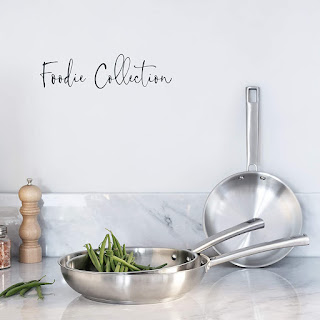Non-stick pans: Guide to choosing
Which of you doesn't have non-stick pans in your kitchen?
The non-stick frying pan is the most sold and used by Italians.
But let's go into detail and try to understand which pans fall into this category, what characteristics they must have, and which are the best non-stick pans to buy and have in your kitchen.
What are nonstick pans?
The main and fundamental characteristics that characterize them are:
- possibility of cooking without oil and condiments in general;
- have uniform cooking over the entire surface of the pan;
- it must not cause food to stick;
- it must not burn food;
- have good thermal and chemical resistance;
- must be manageable and safe.
The materials with which non-stick pans are made
Not all pans that we find on the market are non-stick and have the characteristics listed above. Some are obtained by coating the aluminum pan with non-stick paints. Let's see which are the most used materials and their main characteristics.
Ceramic
Ceramic frying pans are one of the latest developments in non-stick frying pans. Ceramic is non-toxic, durable, and non-porous, making it great for lining pans.
But be careful, it should be emphasized that ceramic pans are not made of ceramic. These are simple aluminum pans coated with paints containing ceramic powders.
- Pros
- The ceramic coating resists very well to high temperatures making the non-stick surface last longer. It has higher scratch resistance.
- Cons
- Non-stick pans are heavier and slower to heat up. When cooking, some foods get stained and it is not possible to bring them back to their original color.
Stone
Stone non-stick frying pans are the most popular, especially in recent years. Their main feature is that of cooking food without oil, without various condiments, and without letting them stick to the bottom of the pan. More than frying pans, they are thick plates.
- Pros
- They are more suitable for dishes that prefer quick cooking and are very easy to clean immediately after use.
- Cons
- They take longer to heat up.
Teflon
Teflon is the main coating for pans with an aluminum structure and is used to make them non-stick. Teflon is applied in sections and their number determines its quality and duration over time. But be careful, the Teflon pans to buy must not contain PFOA (perfluorooctanoic acid). If this substance passes from the pan to the food, it becomes toxic.
- Pros
- They have good non-stick properties and are the cheapest on the market.
- Cons
- They scratch easily and the temperature must be kept under control. If they remain on the fire, reaching high temperatures over 260°, the pan can be thrown away.
Terracotta
Among the coatings for non-stick pans, there is also terracotta, a particular type of ceramic. Of course, like the stone coating, we are not talking about pure terracotta but a non-stick coating characterized by a terracotta effect.
- Pro
- Uniform cooking, ideal for healthy and fat-free cooking;
- Ease of cleaning.
- Cons
- Like ceramic pans heat up very slowly.
- Avoid subjecting terracotta pans to sudden changes in temperature.
Titanium
It is a non-stick material by nature and does not cause any damage to our bodies.
- Pros
- It is a hard, resistant material and conducts heat well.
- Cons
- It is very expensive and titanium pans cannot be used on electric hobs.
In which preparations do non-stick pans give their best?
Non-stick pans are very suitable and give better results in the preparation of egg-based dishes such as omelets, omelets, and fish fillets, and in general, they are excellent for all those foods that need quick cooking. Very suitable also for roasted aubergines and courgettes.
Be careful when cooking the meat because you can risk burning it if it is not cooked properly. Sauces are also worth considering because they may not thicken well.
Of course, the pan makes the difference, so it's important to choose well. Indeed, with some models, the vegetables are burnt, and the omelet sticks.
What problems can be encountered in the use of non-stick pans during the preparation of dishes?
On the market, there are different models and brands of non-stick pans with different characteristics and qualities. Buying a good frying pan allows us to have better results in the kitchen, on the contrary, using a less good frying pan can lead us to not cook our food properly and therefore not obtain the desired results. This is why it is important to choose well and not based on the offer of the moment.
In general, uneven cooking is the most common defect in this type of pan.
The non-stick pans to avoid are those that cook our foods too quickly, not allowing them to cook properly. Sometimes you can even burn the food without it being cooked properly. Conversely, good quality pans allow you to have chef-like results.
The safety of a frying pan
One of the important factors in choosing a frying pan is safety. In fact, in poor-quality models, the handles may come off, the metal parts get too hot, and the bottom of a pan burns.
How much do they cost: the price of non-stick pans
Good performance must also correspond to an honest and not exaggerated price. The pan changes quite frequently.
The best can also be the cheapest because the price does not always correspond with the quality.
In a test carried out by Altroconsumo, it turns out that the best non-stick frying pan tested is also the cheapest.








Comments
Post a Comment